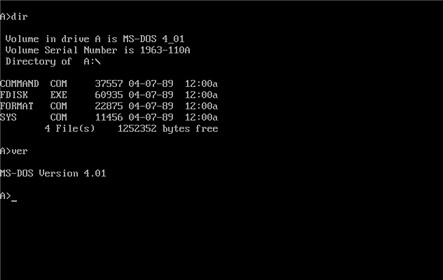Difference between revisions of "History of Computers - MS-DOS"
(→Overview) |
|||
| Line 8: | Line 8: | ||
==Overview== | ==Overview== | ||
| − | As MS-DOS grew and became more wide spread, programers also made their programs DOS friendly. Because of this there were a large amount of applications made for MS-DOS. This factor | + | As MS-DOS grew and became more wide spread, programers also made their programs DOS friendly. Because of this there were a large amount of applications made for MS-DOS. This factor helped MS-DOS become the standard worldwide by 1985. By 1988, there were over 60 million MS-DOS installations and all software was made compatible with it. MS-DOS continued to grow in popularity and usage until 1995 with the release of Windows 95. However, updated versions were included to run with W95 because so many applications still were based on DOS. Updates continued to be made until 2000. |
<ref name="OS"> http://www.operating-system.org/betriebssystem/_english/bs-msdos.htm </ref> | <ref name="OS"> http://www.operating-system.org/betriebssystem/_english/bs-msdos.htm </ref> | ||
| Line 17: | Line 17: | ||
|align="center" |User Interface | |align="center" |User Interface | ||
|} | |} | ||
| + | |||
==Significance== | ==Significance== | ||
MS-DOS was the first wide spread [http://wiki.sjs.org/wiki/index.php/History_of_Computers_-_Operating_System Operating System]. For almost 15 years it was the standard for users and made interaction with a computer easier. MS-DOS paved the way for more graphical user interfaces such as Windows 95, Windows ME, Windows XP, and even Vista. Because MS-DOS was more user friendly then previous [http://wiki.sjs.org/wiki/index.php/History_of_Computers_-_Operating_System Operating Systems], it helped make computers usable for people who weren't as up to date on computer technology, thus spreading the use of computers beyond its old boundries. <ref name="OS"> http://www.operating-system.org/betriebssystem/_english/bs-msdos.htm </ref> | MS-DOS was the first wide spread [http://wiki.sjs.org/wiki/index.php/History_of_Computers_-_Operating_System Operating System]. For almost 15 years it was the standard for users and made interaction with a computer easier. MS-DOS paved the way for more graphical user interfaces such as Windows 95, Windows ME, Windows XP, and even Vista. Because MS-DOS was more user friendly then previous [http://wiki.sjs.org/wiki/index.php/History_of_Computers_-_Operating_System Operating Systems], it helped make computers usable for people who weren't as up to date on computer technology, thus spreading the use of computers beyond its old boundries. <ref name="OS"> http://www.operating-system.org/betriebssystem/_english/bs-msdos.htm </ref> | ||
Revision as of 10:34, 28 August 2011

|
| MS-DOS logo |
Microsoft Disk Operating System (MS-DOS) was released by Microsoft in 1982. It is a 16bit Operating System(OS) which displays a command line interface on a black screen with white letters and numbers.[1] No mouse is required because users are required to type in commands to execute programs. Directly after its release it became the standard OS because the majority of computer companies licensed it. [2]
Contents
Overview
As MS-DOS grew and became more wide spread, programers also made their programs DOS friendly. Because of this there were a large amount of applications made for MS-DOS. This factor helped MS-DOS become the standard worldwide by 1985. By 1988, there were over 60 million MS-DOS installations and all software was made compatible with it. MS-DOS continued to grow in popularity and usage until 1995 with the release of Windows 95. However, updated versions were included to run with W95 because so many applications still were based on DOS. Updates continued to be made until 2000. [2]

|
| User Interface |
Significance
MS-DOS was the first wide spread Operating System. For almost 15 years it was the standard for users and made interaction with a computer easier. MS-DOS paved the way for more graphical user interfaces such as Windows 95, Windows ME, Windows XP, and even Vista. Because MS-DOS was more user friendly then previous Operating Systems, it helped make computers usable for people who weren't as up to date on computer technology, thus spreading the use of computers beyond its old boundries. [2]
Links
http://www.osdata.com/oses/msdos.htm
http://flickr.com/photos/mikemindel/1391886453/
http://en.wikipedia.org/wiki/List_of_Microsoft_operating_systems
http://www.hard-h2o.com/vernoticia/3690.html
References
- ↑ http://www.computerhope.com/msdos.htm
- ↑ 2.0 2.1 2.2 http://www.operating-system.org/betriebssystem/_english/bs-msdos.htm
Page Creator: Bowden Kelly